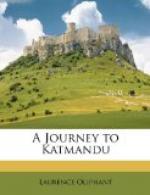At sunset we take a constitutional, followed by our portable residences, into which, after a romantic tea-drinking by the roadside, we turn in for the night, awaking at daylight to find ourselves thirty miles nearer to our journey’s end, in a bungalow precisely similar to the one we had lately quitted, and containing the same rickety table, greasy with the unwiped remains of the last traveller’s meal, which the book will inform you was eaten a month ago—the same treacherous chairs, which look sound until you inadvertently sit upon them—the same doubtful-looking couch, from which the same interesting round little specimens emerge, much to the discomfort of the occupant—the same filthy bathroom, which it is evident the traveller a month ago did not use—the identical old kitmutgar or bungalow-keeper, who looks as uncivilized as the bungalow itself, and seems to partake of its rickety and dirty nature—the same clump of trees before, and the same desert plain behind;—all tend to induce the belief either that you have never left the bungalow in which you spent the previous day, or that some evil genius has transported the said bungalow thirty miles for the express purpose of persecuting you with its horrors and miserable accommodation.
Thus are 700 miles insensibly accomplished in a month by the traveller, who only passes a dreamy existence in dak bungalows, to be roused into violent action on his arrival at some sporting vicinity, a large cantonment, a native Court, rock temples, or other excitements, which must occur in the experiences of the Indian traveller.
I went seventy miles in a bullock hackery, the most unpleasant mode of travelling I conceive that can exist; then one hundred miles in a rickety phaeton with a pair of horses, which was in a slight degree less intolerable; and after visiting Mahabuleshwa, the hill station of Bombay, I reached that mercantile emporium itself, not a little pleased at seeing the sea on the English side of India. I was disappointed with the far-famed Bay; but perhaps it is difficult to do justice to scenery after so much wandering, when the most interesting view is the sight of home. Certainly one’s impressions of a place are regulated in a great degree by the circumstances under which it is visited. Had Bombay been the port of debarkation instead of embarkation, the bay would have been lovely and the various points of view enchanting; as it was, the prettiest object to my perverted vision was the “Malta” getting up her steam to paddle me away from that land, whose marble tombs’ and rock-cut temples will continue to afford attractions to the traveller when its Princes no longer exist sumptuously to entertain them, and whose towering mountains will still disclose fresh wonders when that last independent state which now extends along their base shall have been absorbed into one vast empire.
{121} The arms of his body-guard were bought in London, of Purdy, Lancaster, and other eminent rifle-makers, and cost Jung about 2000 pounds.




